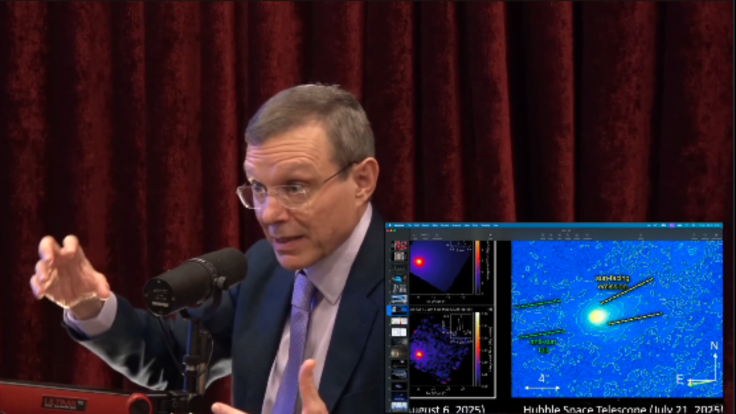3I/ATLAS Theory: Here's Why Avi Loeb Is Convinced It Might Not Be Just a Comet
Is 3I/ATLAS an alien probe? Harvard's Avi Loeb explains why its blue glow and odd acceleration might not be natural.

It's moving too fast. It's glowing the wrong colour. And it's full of the wrong chemicals. Our third-known interstellar visitor, 3I/ATLAS, is not behaving like a typical comet, forcing scientists to ask a tantalising question: what if it's not just a comet?
As this strange object from another star system speeds through our neighbourhood, a series of unexplained features are piling up, and Harvard professor Avi Loeb is laying out his case for why he is convinced it might not be natural.
What Makes 3I/ATLAS So Different?
3I/ATLAS is a special visitor from outside our solar system. Discovered on 1 July 2025, it is only the third known object to have come from another star system, following the discoveries of 1I/'Oumuamua and 2I/Borisov.
Unlike the comets born in our own Oort Cloud or Kuiper Belt, 3I/ATLAS does not orbit the Sun in the usual way. Its trajectory is a one-way ticket.
Its unusual speed and path—a hyperbolic arc that will fling it back out into the void—clearly show it is not bound by our Sun's gravity. Scientists are intensely interested in studying this rare object as it travels through space, as it offers a pristine sample of another solar system's building blocks.
The Baffling Brightening and Colour of 3I/ATLAS
As if its origin wasn't strange enough, the comet's behaviour is also raising eyebrows. Around 29 October 2025, as 3I/ATLAS neared the Sun, it suddenly became much brighter and dramatically changed its appearance. The event was captured by NASA's spacecraft, including STEREO-A, SOHO, and GOES-19.
Unlike most comets, which scatter sunlight to appear white or reddish (due to dust), 3I/ATLAS's bright blue glow is highly unusual. This suggests its light is not just reflected sunlight.
Scientists currently believe that gases like cyanogen and ammonia, which glow blue when ionised, are being released by the comet and are responsible for the light. However, the exact reason for this sudden and intense outgassing is still being studied.
The Unusual Speed and Chemical Profile of 3I/ATLAS
The comet's interstellar credentials are not just in its path, but also in its speed. 3I/ATLAS is moving at a staggering 58 kilometres per second, far faster than most comets native to our solar system.
It is not following a closed orbit; it will pass through our system only once before heading back to interstellar space. This incredible velocity is what confirms it comes from far beyond our Sun's influence.
Furthermore, its chemical make-up is alien to us. Studies have found 3I/ATLAS emits gases like carbon dioxide, cyanide, and atomic nickel. These elements, particularly atomic nickel, are rarely found in such abundance in our own comets.
The presence of these specific chemicals suggests the comet formed far from its original star, in an extremely cold environment. This makes it an invaluable laboratory for understanding how other planetary systems form.
The Great Debate: Is 3I/ATLAS Natural or Not?
Such a collection of anomalies has inevitably led to spectacular theories. Some scientists, most notably Harvard professor Avi Loeb, have hinted that 3I/ATLAScould be more than a natural comet. He has openly speculated it might be a probe from an alien civilisation.
Loeb's conviction is based on several of the unexplained features. He has argued that the strange blue glow, so unusual for a comet, 'could potentially be explained by a hot engine or a source of artificial light.' Furthermore, he has pointed to the recently observed non-gravitational acceleration.
Loeb calculates this acceleration would require a massive loss of material. He posits that if upcoming observations in November and December fail to detect a 'large plume of gas' to explain this push, then the acceleration might be the 'technological signature of an internal engine.'
However, it is crucial to note that most experts and the broader scientific community believe it is a natural object, albeit one with very unusual features. The prevailing theory is that its bizarre characteristics are a product of its formation in a star system with a different chemical composition and history than our own. The scientific community is still debating these ideas as more data is collected.
The Watchers: What Happens Next for 3I/ATLAS?
To solve these mysteries, humanity's most powerful eyes are turned towards the visitor. NASA's Hubble Space Telescope and the James Webb Space Telescope have been watching 3I/ATLAS closely. These powerful observatories are studying its surface, its light spectrum, and its behaviour as it reacts to the Sun's heat.
Upcoming observations in December 2025 are highly anticipated and will provide more information to help solve some of the comet's puzzles. After passing close to the Sun and Earth in late 2025, 3I/ATLAS will continue its journey out of the solar system. It will not come back. Scientists will keep studying it for as long as they can, seizing this rare chance to understand the materials that formed far beyond our solar system.
The debate surrounding 3I/ATLAS boils down to a testable hypothesis. While most of the scientific community is betting on a natural, if exceptionally strange, comet, Harvard's Avi Loeb has drawn a line in the sand: if the Hubble and Webb telescopes see no massive gas plume in December, his 'internal engine' theory gains serious ground.
For now, the world watches and waits for this interstellar mystery to reveal its secrets.
© Copyright IBTimes 2025. All rights reserved.




















